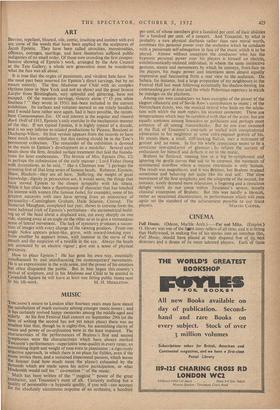ART
BRITISH, repellent, bloated, vile, comic, insulting and instinct with evil are some of the words that have been applied to the sculptures of Jacob Epstein. They have been called atrocities, monstrosities, offences, outrages, sacrilege, and have themselves suffered public indignities of no small order. Of those now crowding the first compre- hensive showing of Epstein's work, arranged by the Arts Council at the Tate Gallery, a whole new generation must be wondering what the fuss was all about.
It is true that the orgies of passionate, and virulent hate have for the most part been reserved for Epstein's direct carvings, but by no means entirely. The fine Madonna and Child with its complex rhythms (now in New York and not on show) and the great bronze Lucifer from Birmingham, very splendid and glittering, have not escaped. Of the massive carvings, Genesis alone (" 0 you white foulness ! " they wrote in 1931) has'been included in the current exhibition. Its surfaces and volumes seemed to me tritely handled, and I would have rather seen again, had it been possible, the recum- bent Consurnmatutn Est. Of real interest is the angular and visored Rock Drill of 1913, Epstein's only exercise in the mechanistic manner of the day. If not typical Epstein, it is highly typical of a decade, and is no way inferior to related productions by Picasso, Boccioni or Duchamp-Villon. Its first version appears from the records to have been much less satisfactory, but this casting should be in the Tate's permanent collection. The remainder of the exhibition is devoted in the main to Epstein's development as a modeller. Several early heads show the firm, detailed surface treatment that laid the founda- tions for later exuberances. The bronze of Mrs. Epstein (No. 12) is perhaps the culmination of the early manner ; Lord Fisher (hung With decorations, as he said, " like a Chistmas tree ") perhaps the arresting first of that long series of famous heads. Robeson, Einstein, Shaw, 13Iackett—they are all here. Suffering, the weight of great knowledge, dignity in persecution are, it would seem, the things that have moved Epstein to the closest sympathy with his sitters. While it has often been a flamboyance of character that has touched his interest with women (the famous Isobel, for example), some of his greatest successes with men have sprung from an aristocracy of personality—Cunningham Graham, Haile Selassie, Conrad, The Somerset Maugham, completed last year, shows in extreme form the, most habitual trick of Epstein's portraiture—the asymmetrical build- ing up of the head about a displaced axis, cut away sharply on one side, slanting away at an angle on the other so as to give a tremendous sense of lateral movement. The lack of symmetry produces a succes- sion of images with every change of the viewing position. From one angle Nehru appears priest-like, grave, with inward-looking eyes ; from another he appears ironic, with humour in the curve of the mouth and the suspicion of a twinkle in the eye. Always the heads are animated by an electric vigour ; give one a sense of physical proximity.
How to place Epstein ? He has gone his own way, essentially uninfluenced by and uninfluencing the contemporary movements. He is an expressionist in the wide sense, and the power of his emotion has often disquieted the public. But in him began this country's revival of sculpture, and in his Madonna and Child to be erected in Cavendish Square he will leave at least one fitting public monu vent


















































 Previous page
Previous page